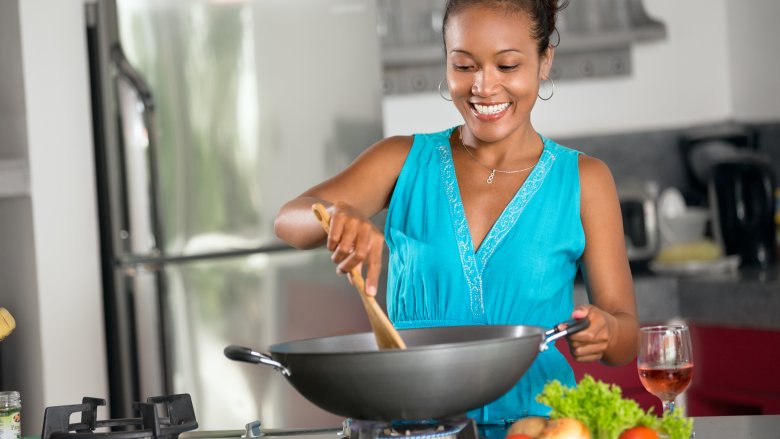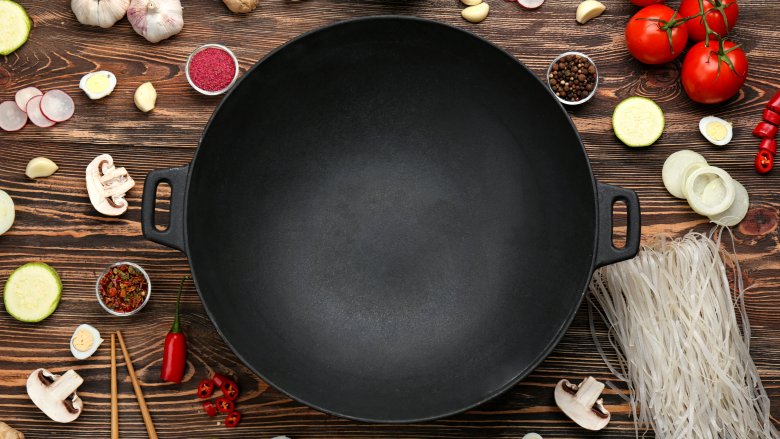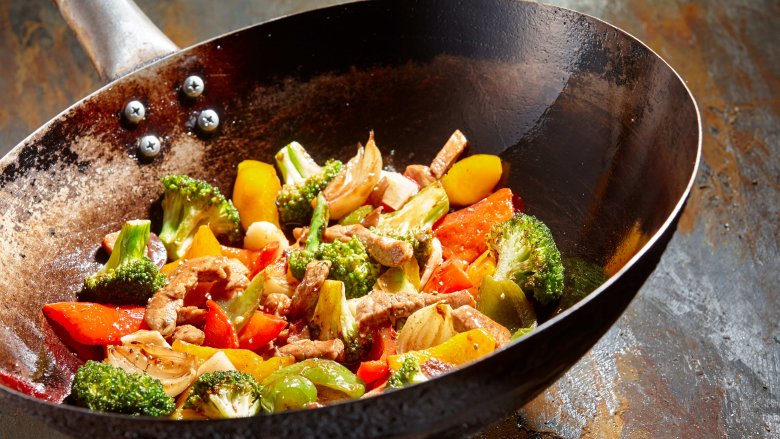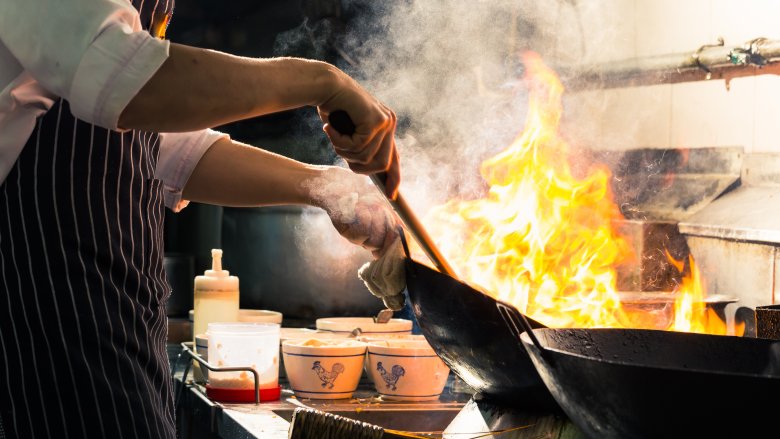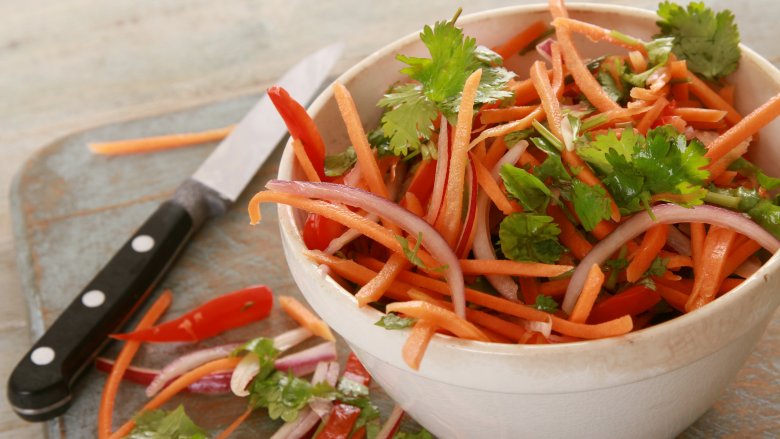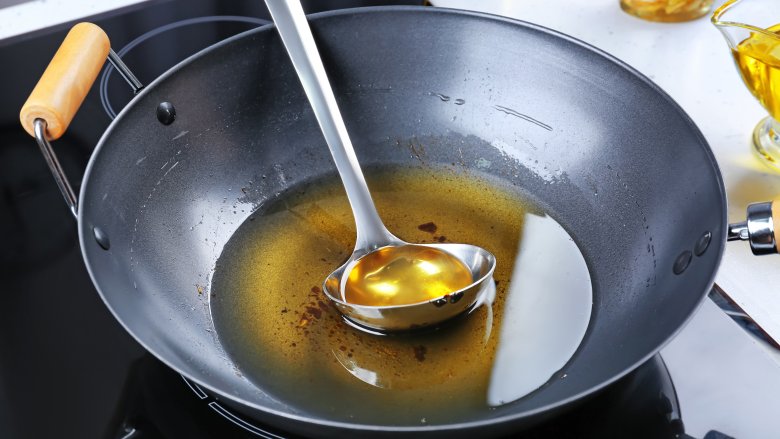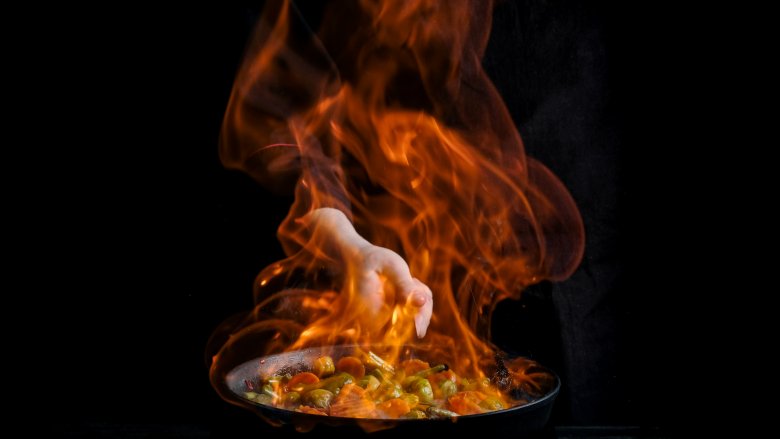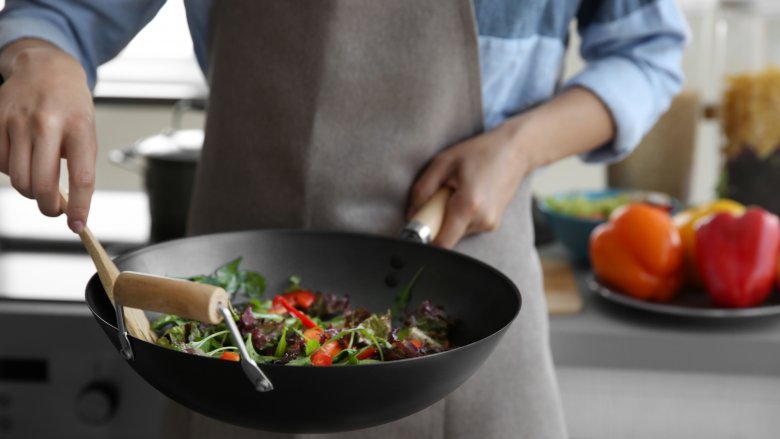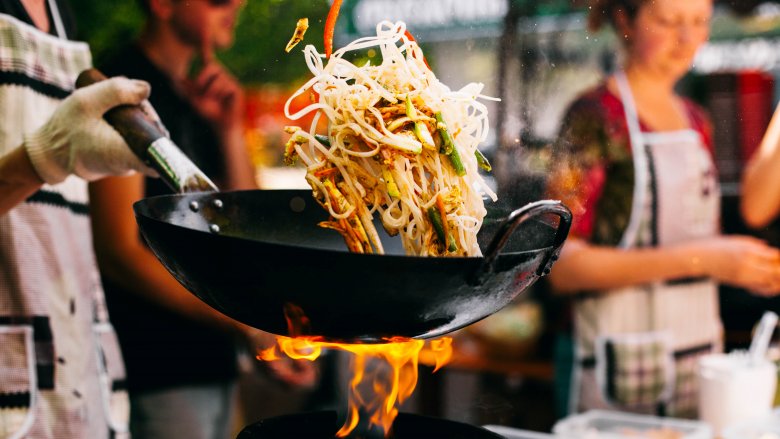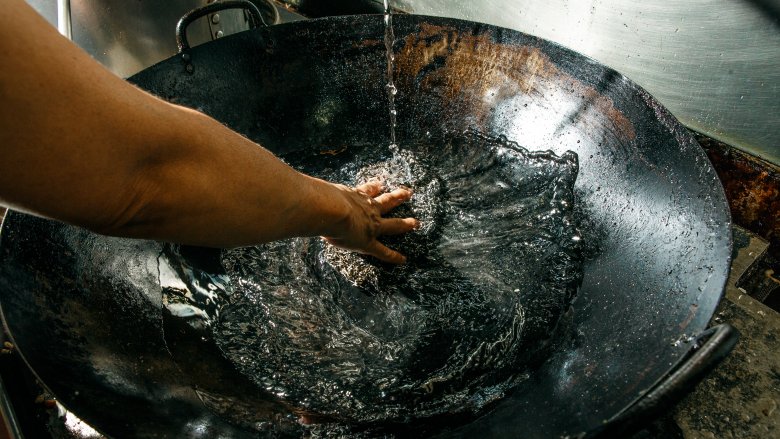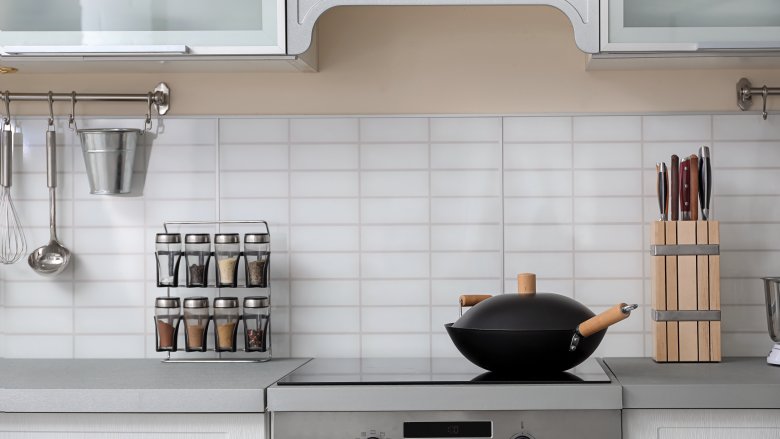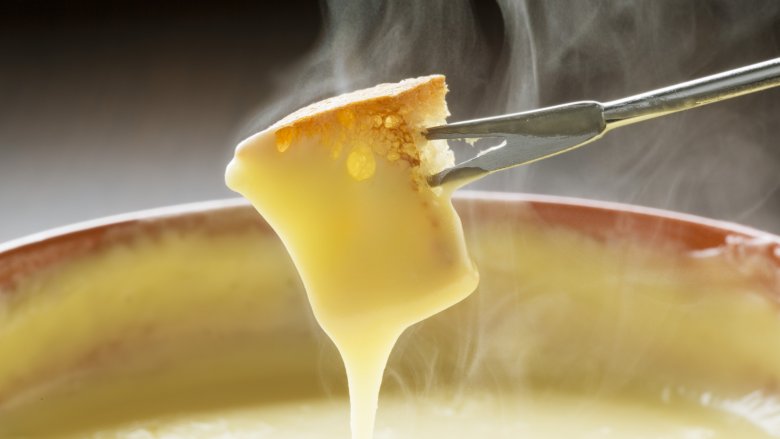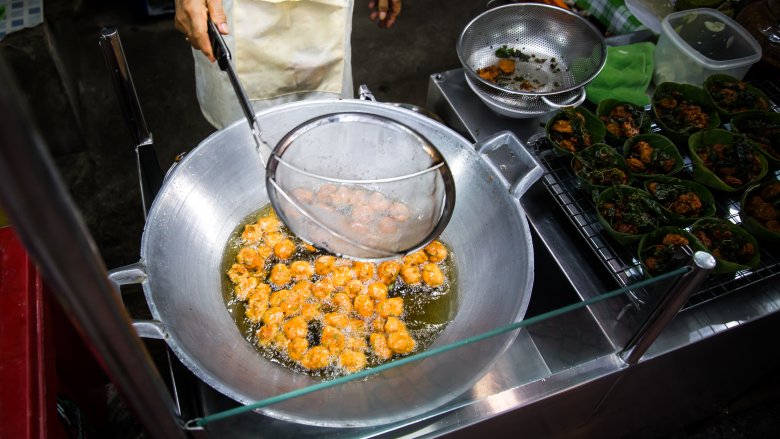Huge Mistakes You're Making With Your Wok
A wok might not be one of the basic tools you outfit your kitchen with, but it is an absolutely wonderful upgrade you'll wonder how you ever did without. Sure, it takes up a lot of space, but almost every kitchen has room for a small pot rack, and that's an excellent place to hang your wok.
And really, it's so useful you should absolutely invest in one, because you'll find yourself using it a surprising amount of the time. And if you're not, that's just one of the mistakes you're making with it.
Cooking with a wok isn't like cooking with a pan or skillet — if you try to apply the same techniques to all of those tools, it's going to go terribly wrong. And it's easy to get it wrong with a wok; there's a reason that some chefs who use it decide to specialize in it, and become known for their mad wok skills. But here's the good news: you don't need to be a professional to make a delicious meal with your wok, you just need to be aware of some of the mistakes you're making, and correct them. Here's how it's done.
You picked the wrong wok
Getting it right with a wok means getting a good start right out of the gate, and that means picking the right one. There are a lot of choices out there, and fortunately, chef Adam Liaw has some valuable tips to steer new users in the right direction (via SBS).
First, size. Bigger isn't always better, and Liaw says the bigger woks out there are generally made for commercial stoves. If you're cooking in your home kitchen, he recommends sticking to one that's 35 centimeters in diameter. Anything larger, and the heat won't be properly distributed.
Then, let's talk materials. He recommends getting carbon steel, because it's durable, easy to clean, won't bend like aluminium or crack like iron, and it will hold its seasoning (more on that in a minute). And even though you might instinctively reach for a non-stick wok, you shouldn't. They're going to be too heavy to maneuver easily, and they're not really designed to be used over the high heat you want when cooking with a wok.
Then, remember you're going to be holding that wok off the stove, so get one with a handle (or handles) that is comfortable for you, preferably one that has wooden and heat-proof grips.
You never seasoned your wok
You might think of seasoning a pan as something you do with cast iron, but you need to do it with your wok, too. Adam Liaw says (via SBS) that part of the reason for seasoning is that nothing will stick to a properly seasoned wok, and that's just going to make life that much easier.
It's also going to make it easier to keep clean, and The Woks of Life says that getting your wok properly seasoned isn't as difficult as you might think.
Start by giving your new wok a quick wash, then dry and cover any handles you won't be using with aluminium foil. Then, put the wok on your stove and turn the heat on high. The wok will start to change color as you hold it over the heat, and it'll probably start to smoke. That's all right — that's residual oils left from the manufacturing process. Heat all areas of the wok completely, turning and tilting it as you go, then set it aside to cool.
Give it another wash, then put it back over a medium heat to dry. Once it's completely dry, add a dash of vegetable oil and lower the heat. Spread it around, and push a paper towel around with a spatula to cover the whole wok as it heats. Once the oil disappears (and your wok starts to change color), you can let it cool, wash it, and repeat the process the next time you cook with it. That's it!
The temperature isn't high enough for your wok
Most of the time, a super-high temperature means you're going to burn the outside of whatever's in your pan before it's cooked all the way through, and it's this belief that brings us to another common mistake that happens when you switch to a wok: you probably don't have the temperature high enough.
According to Andrew Zimmern, one of the keys to getting those stir-fried vegetables just the right texture is to have the heat very, very high — so high that when you throw your ingredients in, they're going to hard sear. And that's key, too: your wok should already be hot before you put any of your meat and vegetables in, so there's no slow rise in temperature. Start each dish by putting the wok — and the wok alone — over the heat, and you'll know you're ready to start cooking only when it starts to smoke.
Chef Ken Hom has also specified (via The Telegraph) how important it is to start with a very, very hot wok and to continue with that high heat. His pro tip? If you're taking your wok off the heat, you're doing it wrong. If you do decide you need to bring the temperature down, use just a dash of water, broth, or rice wine — don't lower the heat.
You're not prepping the ingredients right for your wok
Cooking with a wok is all about speed, and if you're the type that likes to set the pan on the stove and add ingredients as you cook, you're not doing your wok justice. One of Andrew Zimmern's key tips is to prep everything in advance, and have it ready. And that means prepping everything correctly, too.
You'll need to pay close attention to how you're cutting your meat and vegetables. Look at it this way. You're going to want to sear your ingredients fast, so that means you're going to want the most surface area you can get. Cut veggies very, very thin, and cut them on the diagonal to maximize the area that's directly exposed to the heat. Chatelaine recommends cutting your meats against the grain, which will help keep them tender.
Finally, one more bit of prep advice from Grace Young (via Epicurious): Bring your meat to room temperature before throwing it in, as that will help you cook it more evenly.
You're using the wrong oil in your wok
Choosing the right oil can be tough — there are so many out there, after all, keeping their strengths and weaknesses in mind can be a challenge. But according to Andrew Zimmern, picking the wrong oil for using in your wok isn't just going to make it taste a little off, it'll ruin your whole dish.
That's because different oils start to burn at different temperatures, something MasterClass calls the smoke point. Because you're working with extremely high temperatures, you'll need to choose an oil that has a high smoke point so it holds up against the heat and doesn't break down and burn quickly.
Zimmern suggests oils like grapeseed and peanut for using with a wok, partially because of their high smoke point and partially because they're low in polyunsaturated fat. Why does that matter? Because oils high in this type of fat will burn — badly — and turn whatever you're cooking very, very bitter.
You're not managing moisture in your wok right
If you're just slicing and dicing your ingredients then throwing them in the wok... you're doing it wrong — even if you have the temperature of your wok raging super-hot. According to chef Grace Young (via Epicurious), adding ingredients when they're wet or even damp will lower the temperature of your wok to the point where your food is going to start to steam instead of sear. And that makes it incredibly important to keep moisture to a minimum.
But what about the incredible sauce that's all ready and waiting to go on the stir-fry? It's not stir-fry without the sauce, we know. According to chef Ken Hom (via The Telegraph), there's a specific way to cook your ingredients that's going to allow you to manage your moisture correctly: cook your proteins, and drain any extra liquid. Then add your vegetables, and then — at the very end of the process — add your sauce.
You're putting too much food in your wok
When chef Adam Liaw was asked (via SBS) about the absolute, most important piece of advice he could give when it came to cooking with a wok, he stressed how vital it is not to make a very common mistake.
"... don't overcrowd the wok," he says. "That's the number one thing. Even if you do everything else right, and then overcrowd the wok, it's going to turn out awful."
The first reason why goes back to moisture. Even if you pat your ingredients dry before throwing them into your wok, they're going to give off liquid as they start to cook. If the wok isn't overflowing, that liquid will evaporate pretty quickly, and that's exactly what you want.
You also want your ingredients to begin to char, and the way they get that nice char is by coming in contact with the bottom of the wok. If it's too full, neither of those things are going to happen and that's exactly how you'll end up with a soggy dinner.
What should you do? Cook in small batches, and set aside cooked ingredients while you finish. Then, at the end, mix everything together. There's a bonus here, too — if you're on your own for the night, the wok is the perfect size and method to cook a healthy meal for one person.
You're trying to do all the fancy wok flipping
If cooking in a wok still seems intimidating, there's probably one major reason for that. Watch anyone on television cooking in a wok, and you'll probably see them doing all kinds of fancy flipping and tossing the ingredients, so high and so fast that you just know it's an accident waiting to happen in your own kitchen. If you're avoiding the wok because you don't want to clean stir-fry beef off the ceiling and veggies off your dog, don't worry — you shouldn't be trying all that fancy stuff anyway.
And that's according to chef Adam Liaw, who told SBS that there's absolutely no reason for you to try to copy those professionals. Part of the reason for all that flipping is that they're working on incredibly high temperatures — higher temperatures than your stove can probably even get to. Over that kind of heat, the searing processes they're looking for can happen in seconds. For you, you've got a little more time.
In fact, you can even take your time. He adds that the longer your ingredients spend in the air, the less time they're searing and charring in the wok... and that's what you want them to do. So, what should you be doing instead?
Chef Grace Young describes it (via Epicurious) as "tumbling." Rock the wok gently, and tumble the ingredients. That will keep them in contact with the hot surface, and it will help them cook evenly.
You're not cleaning your wok right
We all know that our tools are only as good as we treat them, and if you care for your pots and pans, they'll care for you. But what about your wok?
Your instinct might be to scrub it clean, but that's exactly what you don't want to do — especially after you've worked so hard to season it properly and build up that nice patina. According to chef Grace Young (via Fine Cooking), the best way to clean your wok is also pretty much the easiest way. Skip the soap, and just soak it in hot water for five minutes or so to loosen anything that's stuck to the surface. (And if you rinse it off immediately after plating, you probably won't have that problem at all.) Then, just use a soft sponge and wipe off the surface — and that's it! Abrasive chemicals or sponges can damage the patina of your wok, and that's exactly what you don't want to do.
Finally, she also recommends putting it back on the heat one last time to dry it, just before you put it away. (And don't worry — if the patina on your wok disappears, it's not the end of it. Just re-season it like you did when you first got it, and you'll be all good to go again.)
You're not using your wok to bake
Sometimes, wonderful things happen when you think outside the box. That's true both in and out of the kitchen, so let's talk about why you need to use your wok way more often than you probably are. Should you use your wok as a tool when you bake? Absolutely!
We all know how delicious fresh-baked bread is, and we also know it's a bit of a pain. The process itself is fairly easy (but time-consuming). And let's be honest, if it wasn't for the sticky, floury mess you always seem to make while you're kneading it, you would probably make it more often, right? You can probably guess where this is going.
Solve all your messy bread problems by kneading in your wok. It'll keep all the flour where it's supposed to be, your dough won't stick to the sides, and the shape means it's perfect for pushing and pulling and folding the dough. Clean-up is a breeze, you won't have a thin coating of flour all over your kitchen, and you'll be putting that bread in the oven in no time. Problem solved!
You're not using your wok to fondue
Let's say you're having a few friends over for the evening, and you're trying to come up with something fun to do. Fondue might be the most 1970s-era dinner-party idea ever, but it's still fun. And honestly? If anyone scoffs at the idea of dipping food in melted cheese or chocolate, you probably don't want them at your party anyway.
And here's the brilliant part: you don't need to have one of those terribly dated-looking fondue sets taking up space in your kitchen (or closet), you just need a wok. According to Haaretz, the wok is the perfect thing to melt and serve fondue in. It's the right shape, it's going to hold the heat, and it's easy to move from the stove to the (properly insulated) table. Need to reheat your cheese? Just move it back to the stove for a minute. Brilliant, right? Someone pour the wine and get this party started!
You're only using you wok to make stir-fry
If you're expecting to only break out that wok when your family feels like stir-fry that's not from your local Chinese takeout joint, you're really not taking full advantage of the versatility of this tool. It's taking up a lot of room in your kitchen, after all, and you should use it!
First, a few time-saving ideas. Use it to coat a dinner salad with dressing, use it to toss pasta and sauce, and even better? Use it to coat your popcorn with your preferred seasonings of choice. (Yes, movie night just got better.)
And what else should you use it for? If you're deep-frying anything from chicken wings to donuts, a wok is the perfect shape for that. Those wide, sloped sides are going to minimize splatter, make straining out the burnt bits super easy, and make it easier to avoid burning yourself in the process.
It's also perfect for holding a steamer basket, it's great for braising meats, and it's even possible to turn it into an indoor smoker. How? You just need foil, a rack, and wood chips. You're welcome!
